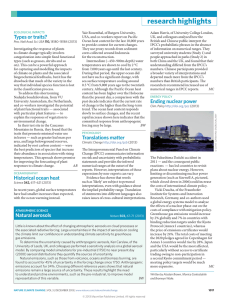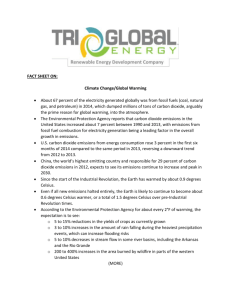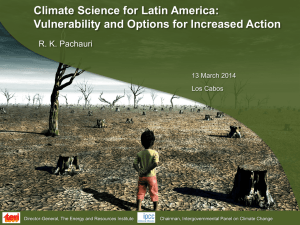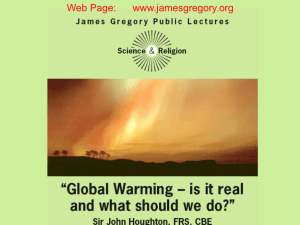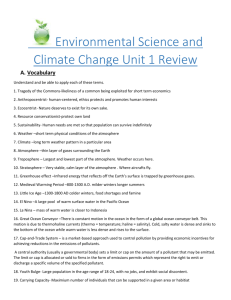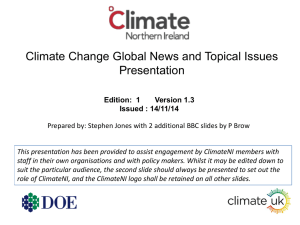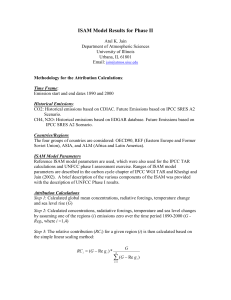What`s new in the Fifth Assessment Report (DOCX
advertisement
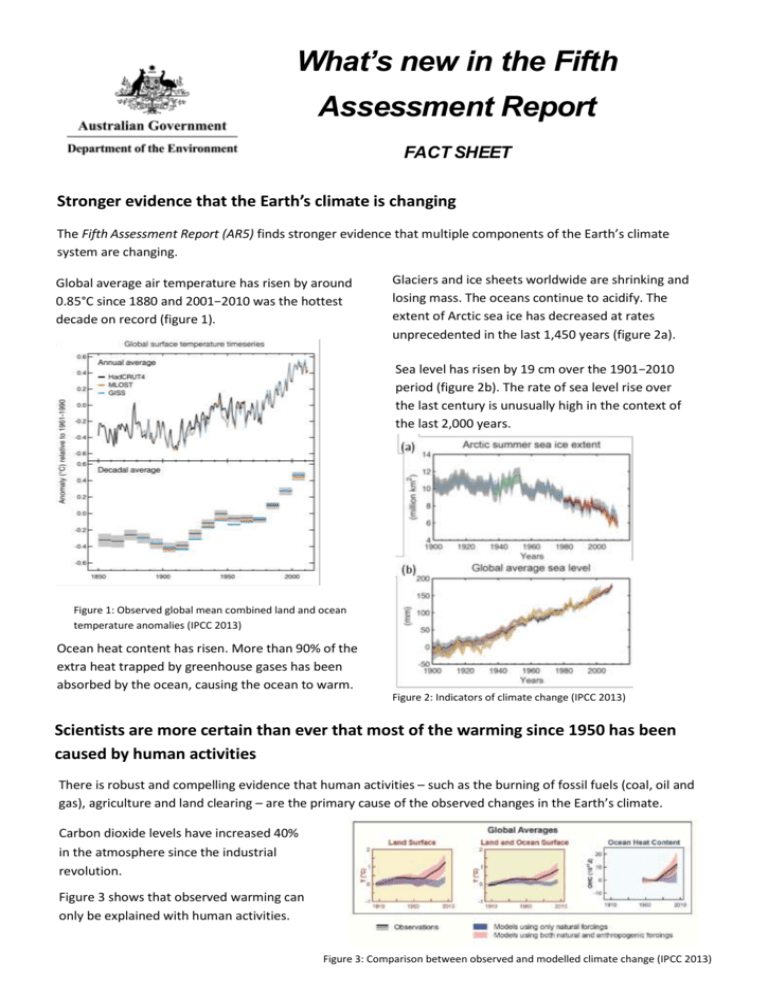
What’s new in the Fifth Assessment Report FACT SHEET Stronger evidence that the Earth’s climate is changing The Fifth Assessment Report (AR5) finds stronger evidence that multiple components of the Earth’s climate system are changing. Global average air temperature has risen by around 0.85°C since 1880 and 2001−2010 was the hottest decade on record (figure 1). Glaciers and ice sheets worldwide are shrinking and losing mass. The oceans continue to acidify. The extent of Arctic sea ice has decreased at rates unprecedented in the last 1,450 years (figure 2a). Sea level has risen by 19 cm over the 1901−2010 period (figure 2b). The rate of sea level rise over the last century is unusually high in the context of the last 2,000 years. Figure 1: Observed global mean combined land and ocean temperature anomalies (IPCC 2013) Ocean heat content has risen. More than 90% of the extra heat trapped by greenhouse gases has been absorbed by the ocean, causing the ocean to warm. Figure 2: Indicators of climate change (IPCC 2013) Scientists are more certain than ever that most of the warming since 1950 has been caused by human activities There is robust and compelling evidence that human activities – such as the burning of fossil fuels (coal, oil and gas), agriculture and land clearing – are the primary cause of the observed changes in the Earth’s climate. Carbon dioxide levels have increased 40% in the atmosphere since the industrial revolution. Figure 3 shows that observed warming can only be explained with human activities. Figure 3: Comparison between observed and modelled climate change (IPCC 2013) For the first time, the IPCC provides estimates of the total allowable global emissions in order to limit temperature rise to 2°C above pre-industrial levels Most nations of the world have agreed that a global temperature rise beyond 2°C relative to pre-industrial poses unacceptably high risks to humanity. Temperature rise is already nearing 1°C, halfway to that limit. The AR5 highlights that in order to meet the international goal of 2°C compared to the period 1861-1880, the likely total allowable global emissions is about 1,000 billion tonnes of carbon. By 2011, around half of this budget had already been emitted. If emissions of greenhouse gases other than carbon dioxide (eg. methane and nitrous oxide) are accounted for, the likely allowable emissions are reduced to 790 billion tonnes of carbon. If emissions continue to track at the top of IPCC scenarios, global average temperature could rise by between 3.2°C to 5.4°C by the end of the century (relative to a 1850-1900 baseline). If emissions track along the lowest scenario, then global average temperature could rise from 0.9-2.3°C (relative to a 1850 -1900 baseline). Surface temperature change will not be uniform and warming over land is expected to be larger than over the ocean (figure 4). The speed and extent at which the climate continues to change will depend on how much more carbon dioxide and other greenhouse gases we emit into the atmosphere from today. Significant reductions in global emissions will be required to have a good chance of stabilising the climate at a global temperature rise of no more than 2°C. Improved understanding of sea level rise and higher projections of global average sea level rise Improved understanding of the major polar ice sheets (Greenland and Antarctica) has given scientists greater confidence in projections of sea level rise. If emissions continue to track at the top of IPCC scenarios, global average sea level could rise by nearly 1 m by 2100 (0.52−0.98 from a 1986-2005 baseline) (figure 5). If emissions track along the lowest scenario, then global average sea level could rise by 0.28-0.60m by 2100 (from a 19862005 baseline) Sea level will continue to rise after 2100, and for the first time the IPCC provides projections for 2300. Sea level rise by 2300 could be kept to less than 1m if concentrations of carbon dioxide in the atmosphere are stabilised below 500ppm, or could reach up to 3m if concentrations of carbon dioxide rise above 700ppm. Sustained warming of the Earth’s climate could lead to the complete loss of the Greenland Ice Sheet, and could cause global sea level in the long term to rise up to 7m.


